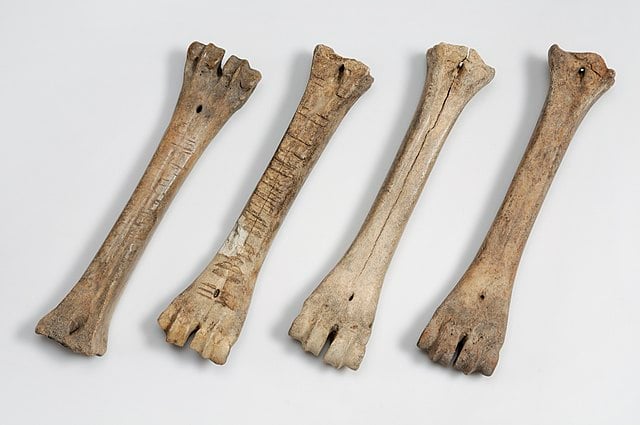 Bronze Age Ice Skates. Credit: The Swedish History Museum / Wikimedia Commons / CC BY 2.0
Bronze Age Ice Skates. Credit: The Swedish History Museum / Wikimedia Commons / CC BY 2.0Archaeologists claim they have discovered Bronze Age ice skates made out of bones. The research was recently published in the Institute of Archeology CASS by Zhou Ye.
Two pairs of animal bone skates, believed to be 3,500 years old, were found in China’s Xinjiang region. According to researchers, these skates, made from ox and horse bones, are a first-of-its-kind discovery in China.
Archaeologist Ruan Qiurong, from the Xinjiang Institute of Cultural Relics and Archeology, revealed that these skates are quite similar to ice skates found in prehistoric Europe.
This discovery has led experts to believe that there was an exchange of information between the ancient West and the East during the Bronze Age. The bone skates are rare physical evidence that can be used to study the origins of ice skating in China.
Moreover, based on the image, and experts’ reviews, the skates’ blades have two perforations on the front and back, with leather straps that would have been tied to the wearer’s shod feet.
The front of the skates comes to more of a point while the back widens to a blunt end. Although they are flat in comparison to modern ice skate blades, the curvature and carving of the bone formed enough of a cutting edge to allow the wearer to glide in the melt created by the ice surface.
https://t.co/cyKogq2llW Ancient Animal Bone Ice Skates Found in China’s “Birthplace of Skiing” https://t.co/4H6yz5ORoe pic.twitter.com/GRMgRUSXFl
— Billy Carson II (@4biddnKnowledge) March 1, 2023
Not the oldest skates
Although the bone skates found at the site are not the oldest known, they are remarkably similar to skates discovered in Finland that date back 5,000 years. Similar ice skates have been found at archaeological sites across northern Europe.
Experts believe that the Finnish skates were used by ancient people in the predominantly flat regions of southern Finland, which are dotted with tens of thousands of small lakes that freeze over in the winter.
Jirentai Goukou archaeological site
Jirentai Goukou site consists of a residential area and the remains of a high platform, located in Chaleger Village, Kemeng Township, Nilek County.
The high platform remains, surrounded by mountains and facing the water, are about 1,000 meters south of the residential area in the north.
Between 2019 and 2022, archaeologists conducted extensive research on the local and central tombs of the high platform remains.
Their findings revealed that this site boasts the largest, highest-standard, and best-preserved stone tomb architectural remains from the Bronze Age in Xinjiang and even the Eurasian grassland.
The remains of Gaotai have been dated back to between the 16th century BC and the 15th century BC.
Wooden wagon parts
There are more than 40 pieces of wooden wheels and components unearthed from the Gaotai site in Jirentaigoukou, Nilek, Xinjiang. This discovery is the earliest, largest and most complete physical data of wooden wheels in China. pic.twitter.com/ffAEjaPkHN
— alang (@alang73723150) February 27, 2023
In addition to the discovery of the bone skates at the Goaotai Ruins, archaeologists found dozens of wooden wagons or carts at the site.
These wagons appear to have been used to build the tomb platform and include 11 solid wooden wheels and over 30 wooden parts, such as rims and shafts.
Archaeologist Qiurong explained at a news conference that the wagons were likely dismantled and intentionally buried after their use in constructing the high platform.

 1 year ago
64
1 year ago
64











 English (US)
English (US)